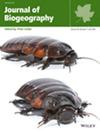Genomic Footprints of Ancient Multi-Species Introgression Events Among Allopatric Australo-Papuan Butcherbird Species
Abstract
Aim
Climate change has influenced the evolution of the world's biota, shaping species distributions, promoting diversification and causing extinctions. The turbulent climatic oscillations of the Pleistocene, which caused repeated periods of isolation and secondary contact, have left lasting signatures on the genomes of species across the world. The resultant reticulate histories are difficult to untangle, yet offer unique insights, capturing responses to climate change that would otherwise be undetected and providing empirical case-studies of the impact of introgression tens of thousands of years later. Here, we explore such dynamics using three currently allopatric species of Australian butcherbirds. We specifically test long-standing biogeographic hypotheses concerning the role of intermittent Pleistocene land-bridges and climatic oscillations in facilitating secondary contact.
Location
Australia and New Guinea.
Taxon
Silver-backed Butcherbird Cracticus argenteus, Black-backed Butcherbird Cracticus mentalis and Grey Butcherbird Cracticus torquatus (Passeriformes: Artamidae).
Methods
We generated genomic data from museum specimens to infer species relationships, test taxonomic boundaries and elucidate the history of gene flow in this species complex.
Results
We uncovered genomic evidence of multiple ancient introgressions into savannah-adapted C. argenteus from both savannah-adapted C. mentalis and more arid-tolerant C. torquatus despite their current allopatry. This supports biogeographic hypotheses concerning both the role of the Arafura Shelf in maintaining genetic connectivity between savannah-adapted species in Australia and New Guinea and the expansion of aridity during glacial maxima in promoting range expansions in arid-tolerant species.
Main Conclusions
Our data showcase how genomic signatures retained over generations can reveal unexpected insights about evolutionary history, as well as expand our understanding of how guilds of similarly adapted species may have responded concordantly to paleoclimate change. These insights have important implications for biodiversity conservation, increasing our understanding of how secondary contact driven by climate change might impact species in the future.


 求助内容:
求助内容: 应助结果提醒方式:
应助结果提醒方式:


